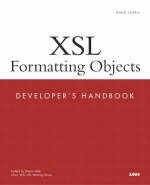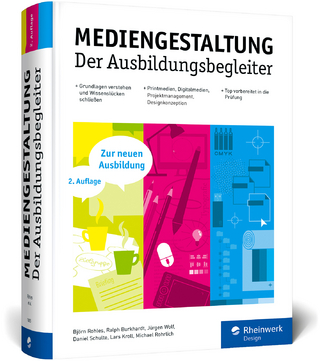
XSL Formatting Objects Developer's Handbook
Sams Publishing (Verlag)
978-0-672-32281-5 (ISBN)
- Titel ist leider vergriffen;
keine Neuauflage - Artikel merken
XSL Formatting Objects Developer's Handbook is a syntactical reference and a guide for developing practical solutions using the complete XSL toolkit. In exploring the available tools and architectures, the book allows programmers to understand and apply XSL as practitioners. XSL-FO is a complex specification that provides a framework for describing detailed document formatting characteristics. A primary goal of XML is to separate the data from presentation. Unlike HTML documents, XML documents contain no information about how those documnets will appear when displayed. The XSL-FO specification provides a standardized way to build stylesheets that express document formatting in pure XML notation.
Doug Lovell taught himself the Basic programming language on a PDP-11 time-sharing terminal when he was a young, impressionable freshman in high school. He saved his programs on punched paper tape, which he rolled up, banded, and stored in tobacco tins supplied by his pipe-smoking mathematics teacher. After becoming a certified flight instructor in Ohio and then moving to New York City to earn a fine arts degree in photography, Doug joined the electronic prepress and digital typesetting facility at Time, Inc. He picked up typesetting and prepress knowledge by working for a few years making Time, Life, Fortune, People, and Sports Illustrated ready for the presses. While working prepress, he partnered in building and operating a business selling graphics tablets for the Commodore Amiga computer; he also wrote a program for animated cartoon drawing, for which he procured his first patent. He left Time to become a resident computer whiz for an engineering firm and to attend graduate school for a degree in computer science. Now Doug works as a software engineer for IBM Research. Typesetting got a grip on him again when he pulled duty to satisfy all the hard-copy requirements of the AutoLoan Exchange project. The project pioneered the process of applying for, approving, and closing automobile loans on the Internet. Doug applied the TeX typesetting language to typeset individualized loan contracts on demand. TeX was most popularly used to typeset mathematics, physics, chemistry, and computer science journals; this may have been the most commercial application of TeX ever undertaken. Doug's most recent program is an implementation of XSL Formatting Objects written with Java. He also has written several tools for working with XML and XSLT, early versions of which appeared on IBM's alphaworks new technologies Web site, and invented TeXML¿an XML vocabulary for expressing TeX typesetting documents. He lives and breathes in the beautiful mid-Hudson Valley of New York, loves to hike the mountaintops, and flies aerobatics wherever he's allowed.
1. Introduction.
Who Needs FO? What Do You Need to Know? Overview of the Book. Fine Print.
2. From Content to Presentation.
Aviation Weather Example. XML Encoded Weather. Some Common Templates. A Style Sheet to Produce HTML. A Style Sheet to Produce XSL FO. A Style Sheet to Produce WML. Summary.
3. Tools and Implementations.
Online Resources. Transform Engines. Formatters. Editors. Summary.
4. Hello XSL World.
A First XML/XSL Pair. A Style Sheet for the Root Rule. Summary.
5. Color, Fonts, and Rules.
A Bulletin. Skeletons in the Closet. Font Selection. Rules and Borders. The Colorful Truth. Summary.
6. Block and Inline.
Box Model. Screenplay Example. block and block-container. Inheritance and the Wrapper. inline and inline-container. Space, Margins, and Indents. Justification. text-transform. Summary.
7. White Space and Line Handling.
Ignoring Space and Newlines. Honoring Newlines. Honoring Spaces. Word Space. Line Wrapping Override. Leading. Subscripts and Superscripts. Paragraph Separation. Summary.
8. Page Styling.
Simple Page Model. Flow and Static Content. Sequences. Summary.
9. Tables and Alignments.
Tabular Alignment. Separate and Collapsed Borders. Explicit Rows. Table Column Definitions. Placing Headers and Footers on a Table. Column and Row Spanning. Content of a Cell. Captioning a Table. Summary.
10. Lists and Leaders.
Structure of a List. Bullets and Checklists. Enumerated List. Descriptive List. Lead Me On. Summary.
11. Keeps, Breaks, and Columns.
A Sample Input Document. Columns. Play for Keeps or Break It Up. Summary.
12. Embedding Diagrams and Images.
Embedding an External Resource. Embedding a Diagram. Placement and Alignment. Character. Background Effects. Summary.
13. Footnotes and Floats.
An Epistle with Footnotes and Floats. Footnotes. Before Floats. Side Floats. Summary.
14. Dynamic Effects.
Scrolling. Hyperlink. Altered States. Toggle Switch. Summary.
15. Going Global.
Writing Direction. Mixing Scripts. Summary.
Appendix A. Basics of the XSL Transform.
The Processing Model. Reorganizing the Input. Processing Text. Processing Attributes. Summary.
Appendix B. A Concise Listing of Formatting Objects.
Formatting Object Categories. Formatting Objects.
Appendix C. A Concise Listing of Properties.
Property Categories. Property Types. Properties.
Index.
| Erscheint lt. Verlag | 13.11.2002 |
|---|---|
| Verlagsort | Indianapolis |
| Sprache | englisch |
| Maße | 188 x 231 mm |
| Gewicht | 742 g |
| Themenwelt | Mathematik / Informatik ► Informatik ► Grafik / Design |
| Mathematik / Informatik ► Informatik ► Web / Internet | |
| ISBN-10 | 0-672-32281-1 / 0672322811 |
| ISBN-13 | 978-0-672-32281-5 / 9780672322815 |
| Zustand | Neuware |
| Haben Sie eine Frage zum Produkt? |
aus dem Bereich


